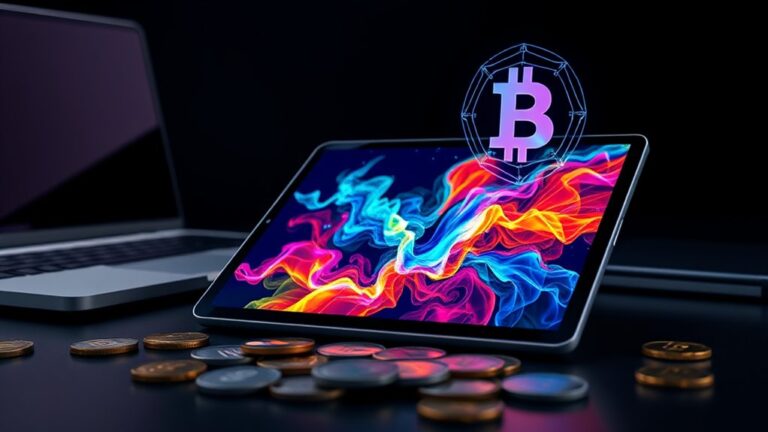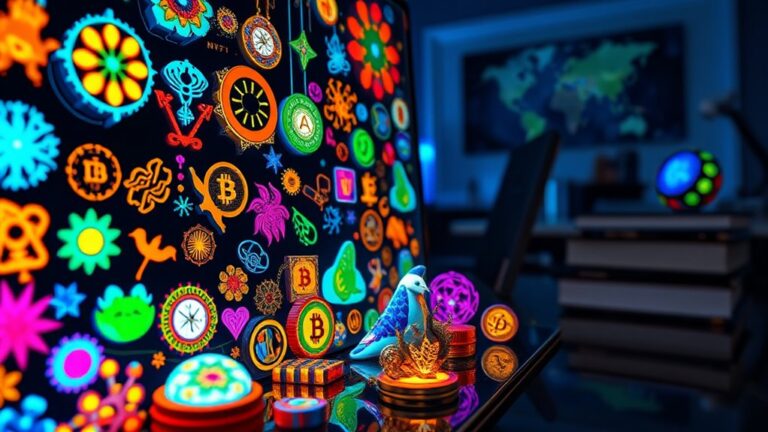
Metaverse and Virtual Land NFTs: Unlocking New Frontiers
The metaverse is an interconnected digital universe where virtual land is represented as non-fungible tokens (NFTs) on blockchain platforms, establishing a new form of ownership. This digital real estate allows users to buy, sell, and develop land, creating immersive experiences and economic opportunities. Major companies and innovative technologies are driving growth in this space. Understanding the dynamics of virtual land can reveal its potential impact on future economic trends and virtual interactions within the metaverse.
Key Takeaways
- The metaverse offers immersive, interconnected digital spaces, enabling real-time interactions and economic activities through technologies like VR and AR.
- Virtual land in the metaverse acts as digital real estate, represented by NFTs and secured via blockchain, providing ownership and transaction capabilities.
- Major platforms like Decentraland and The Sandbox allow users to create and trade virtual land, fostering a vibrant marketplace for digital assets.
- The virtual real estate market is projected to grow significantly, driven by increasing demand and diverse use cases in gaming, advertising, and social experiences.
- Legal frameworks are evolving to address property rights and compliance issues, facilitating investment and innovation in the metaverse and virtual land sectors.
Understanding the Metaverse: A New Digital Realm
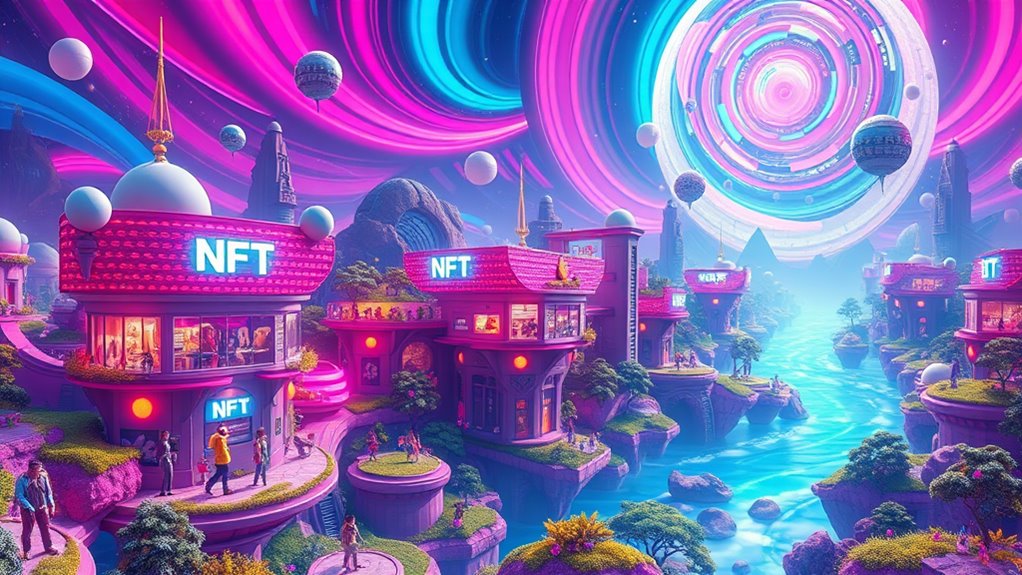
As technology continues to advance, the concept of the metaverse has emerged as a new digital domain where users can engage in immersive experiences.
Defined as an interconnected digital universe, the metaverse allows users to interact with each other and digital objects in real time. This environment utilizes various technologies, including virtual reality (VR), augmented reality (AR), and mixed reality (MR), to create a blend of the physical and digital worlds.
The metaverse aims to provide a persistent space that fosters identity, history, and economic activities. It is evolving from niche applications into a more integrated platform, considerably supported by substantial investments from major companies like Meta, indicating a commitment to its future development and potential impact on society. Furthermore, the metaverse’s growth is intricately linked to cryptocurrency integration, which facilitates secure transactions and the development of virtual economies.
The Concept of Virtual Land and Its Significance
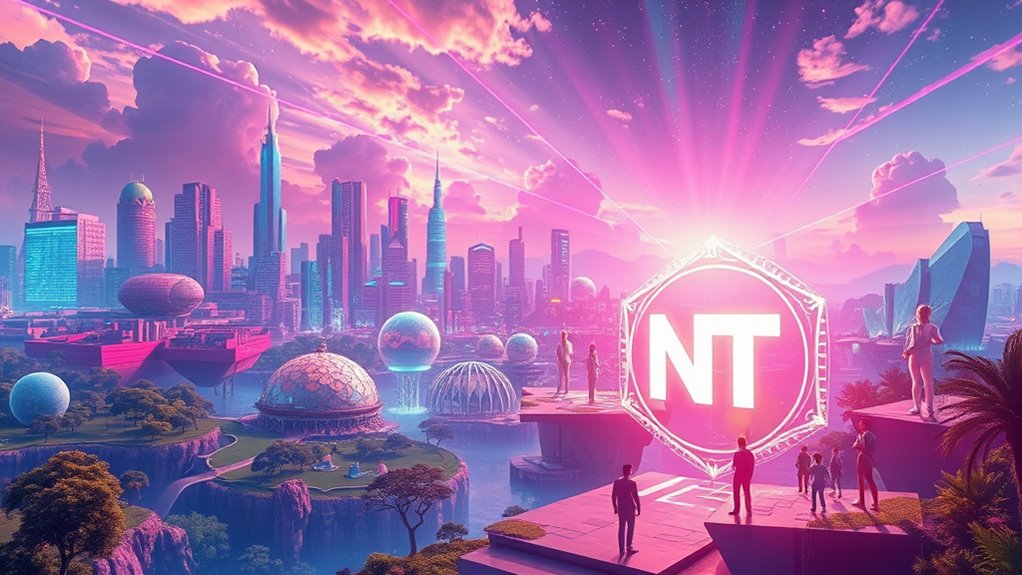
Virtual land represents a unique aspect of the metaverse, functioning as digital real estate where users can own and develop spaces within various virtual environments. This ownership is facilitated by non-fungible tokens (NFTs), which serve as digital deeds, ensuring secure and verifiable transactions through blockchain technology.
Virtual land can be bought, sold, or rented on platforms like OpenSea and Rarible, often utilizing cryptocurrencies. Its economic significance parallels traditional real estate, with potential for investment and speculation based on future value growth.
Additionally, the utility of virtual land—such as hosting events or advertising—contributes to its value. As the metaverse expands, the demand for virtual land continues to grow, highlighting its importance in the digital economy. Furthermore, the rise of utility NFTs is expected to enhance the value of virtual land by providing owners with unique benefits and experiences within the metaverse.
Major Players Shaping the Metaverse Landscape
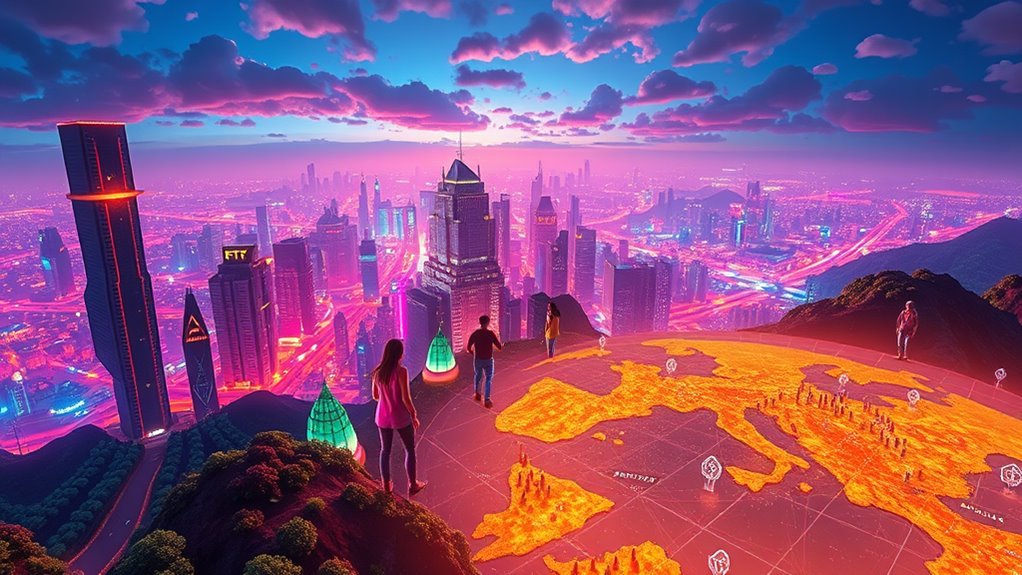
The metaverse landscape is shaped by several major platforms, including Roblox, Fortnite, and Meta Horizon, which offer diverse experiences for users.
Key partnerships and collaborations among industry leaders, such as Microsoft and Epic Games, further drive technological innovations that enhance user engagement and functionality.
As these players continue to evolve, their contributions are essential to the overall growth and development of the metaverse ecosystem.
Leading Metaverse Platforms
Numerous platforms are shaping the landscape of the metaverse, each contributing unique features and experiences that attract diverse users.
Decentraland allows individuals to purchase virtual land and create digital assets through blockchain technology.
The Sandbox offers a voxel-based environment where users can build and sell digital creations.
Roblox stands out with a massive user base, providing a wide array of immersive games and social experiences.
Horizon Worlds, developed by Meta, focuses on user-generated content in virtual reality.
Meanwhile, Spatial delivers immersive virtual workspaces accessible across various devices.
Together, these platforms exemplify the metaverse’s potential, offering users opportunities for creativity, collaboration, and economic engagement in a rapidly evolving digital landscape.
Key Partnerships and Collaborations
As companies recognize the potential of the metaverse, strategic partnerships and collaborations have emerged as vital components in shaping its landscape.
These alliances enable businesses to enhance their offerings and reach broader audiences. Key partnerships include:
- Walmart and Minecraft: Creating immersive experiences through games like “Skyward.”
- Unity and Walmart: Integrating Walmart’s commerce APIs into Unity games for real-time transactions.
- Meta’s Horizon Worlds: Aiming to enhance social interaction within the metaverse.
- Spatial’s Virtual Workspaces: Fostering collaboration through realistic avatar-based meetings.
- Decentraland’s Blockchain Integration: Securing digital asset ownership and fostering a user-driven economy.
These collaborations not only enhance user engagement but also contribute to the evolving infrastructure of the metaverse, setting a foundation for future growth. Moreover, the integration of NFT use cases across various sectors is paving the way for innovative solutions within this digital realm.
Technological Innovations Driving Growth
Technological innovations play an essential role in driving growth within the metaverse, shaping the landscape through advanced tools and systems. Key advancements include Extended Reality (XR), which enhances immersion through augmented and virtual reality, and Artificial Intelligence (AI), enabling realistic avatars and interactive environments.
Brain-Computer Interfaces (BCIs) are emerging as a novel way for users to interact seamlessly with digital spaces. Infrastructure improvements, such as 5G networks and edge computing, guarantee faster data processing and connectivity.
Additionally, blockchain technology secures transactions and authenticates ownership within the metaverse. These innovations collectively create a more engaging user experience, stimulate economic opportunities, and foster robust digital economies, setting the stage for continued growth and exploration in virtual domains.
How Blockchain Technology Facilitates Ownership

Blockchain technology serves as the backbone for ownership in the metaverse, providing a reliable framework for virtual land transactions. Its decentralized nature guarantees that ownership records are secure and transparent, allowing users to trust the system.
Blockchain underpins metaverse ownership, ensuring secure, transparent virtual land transactions that foster user trust.
Key aspects include:
- Immutable Ledger: Ownership records cannot be altered once established, guaranteeing accuracy.
- Smart Contracts: Automated agreements enforce ownership rules without manual intervention.
- Tokenization: Digital assets are converted into tokens, enhancing transferability.
- Transparent Transactions: All transactions are publicly recorded, reducing fraud risks.
- Digital Identity Management: Blockchain secures user identities across various platforms.
Through these mechanisms, blockchain establishes a robust environment for managing virtual land ownership, promoting confidence and accessibility in the burgeoning metaverse economy. Additionally, its decentralized, immutable digital ledger ensures that all transactions are verified securely across a network, further enhancing trust among participants.
Methods for Acquiring Virtual Land
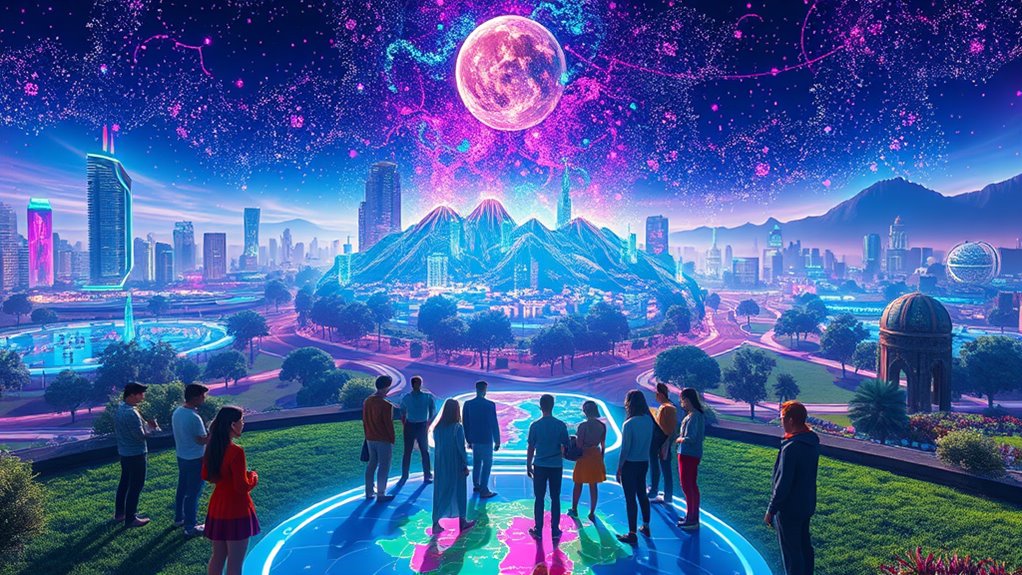
Acquiring virtual land involves several methods, primarily through direct sales from metaverse platforms and secondary marketplaces.
Buyers typically need to complete cryptocurrency transactions to secure ownership rights, often using platform-specific tokens.
Understanding these acquisition methods is essential for traversing the evolving landscape of virtual real estate.
Primary Sales Opportunities
In the evolving landscape of the metaverse, primary sales opportunities for virtual land are increasingly becoming accessible to a wide range of users. Users can acquire virtual land through various platforms that facilitate primary sales, typically represented as NFTs to guarantee unique ownership.
Key aspects of these opportunities include:
- Key Platforms: Decentraland, The Sandbox, Treeverse, Somnium Space, and Cryptovoxels.
- NFT Ownership: Each plot of land is secured as a unique NFT.
- Blockchain Integration: Most platforms utilize the Ethereum blockchain.
- Purchase Process: Buyers need a compatible wallet and the platform’s cryptocurrency.
- Marketplace Transparency: Clear information on available land, prices, and ownership is often provided.
These factors collectively enhance the accessibility and clarity of acquiring virtual land in the metaverse. Additionally, the growth of the NFT market is expected to create new opportunities for real-world asset tokenization, allowing users to leverage physical assets in virtual environments.
Secondary Marketplaces Overview
Virtual land trading has gained significant traction, particularly through secondary marketplaces that facilitate the exchange of virtual land NFTs.
Platforms such as OpenSea, Rarible, and X2Y2 provide users with global access to trade, breaking down geographical barriers. These marketplaces enable buyers and sellers to negotiate prices based on demand and the strategic value of virtual parcels.
Transactions are securely recorded on the blockchain, ensuring transparency in ownership transfers. Additionally, traded land can serve various purposes, including event hosting and real estate development. As the demand for virtual properties increases, platforms like OpenSea are becoming essential for users looking to explore diverse NFT options.
As the number of secondary marketplaces continues to grow, competition increases, offering diverse options for investors. However, users must remain aware of transaction fees and market fluctuations that can affect profitability.
Cryptocurrency Payment Requirements
Purchasing virtual land requires an understanding of specific cryptocurrency payment methods and the technology that underpins them. Transactions on platforms like Decentraland and The Sandbox primarily use cryptocurrencies, necessitating knowledge of various aspects to guarantee successful purchases.
Essential considerations include:
- Blockchain Technology: Guarantees secure ownership records.
- Native Tokens: Familiarity with MANA and SAND as primary tokens.
- Wallet Compatibility: Use of wallets like MetaMask for storing cryptocurrencies.
- Transaction Costs: Understanding lower fees compared to traditional methods.
- Cross-Platform Functionality: Ability to convert and use currencies across different metaverse platforms.
Additionally, understanding the concept of NFTs and their trading can enrich your experience in the virtual land market. This knowledge is vital for traversing the evolving landscape of virtual land acquisition, guaranteeing secure and efficient transactions.
Exploring Different Metaverse Platforms

The landscape of the metaverse is populated by various platforms, each offering unique experiences and opportunities for users.
Decentraland allows individuals to buy and sell virtual land, creating content in a blockchain environment. In contrast, The Sandbox focuses on voxel-based gaming and asset design, enabling user-generated experiences.
Illuvium immerses players in a blockchain-driven gaming world, while Axie Infinity emphasizes trading NFT creatures.
Roblox promotes social interaction through game development tools. Emerging platforms like Star Atlas and Horizon Worlds provide novel gaming and social experiences, respectively.
Many of these platforms utilize blockchain for secure transactions, and NFTs for asset ownership, enhancing user engagement and monetization opportunities.
This diverse array of platforms illustrates the metaverse’s potential for innovation and community building.
Diverse Use Cases for Virtual Land

In the metaverse, diverse use cases for virtual land NFTs have emerged, transforming how individuals and businesses engage with digital spaces.
These applications showcase the potential of virtual land, offering opportunities that enhance experiences while creating value.
- Building and Development: Constructing homes or commercial spaces on NFT land.
- Hosting Events and Experiences: Organizing social gatherings or exhibitions in virtual venues.
- Advertising and Marketing: Utilizing digital land for brand promotion and advertisements.
- Gaming and Interactivity: Enhancing gaming experiences with interactive elements on virtual properties.
- Community Building: Fostering social interactions through shared virtual spaces.
These varied applications illustrate the versatility of virtual land NFTs, catering to both personal interests and commercial ventures within the metaverse.
Economic Trends and Market Growth in Virtual Real Estate

The economic landscape of virtual real estate is evolving rapidly, with significant growth projected in the coming years.
By 2034, the market is anticipated to expand from $4.12 billion in 2025 to $67.40 billion, driven by increasing investment interest and the appeal of diverse revenue opportunities.
As the valuation dynamics shift and new investment avenues emerge, understanding these trends becomes essential for stakeholders in the metaverse.
Market Valuation Dynamics
As interest in virtual real estate continues to evolve, understanding the market valuation dynamics becomes essential for potential investors and stakeholders.
Recent trends show significant price fluctuations, with some metaverse land plots experiencing declines of up to 95% from their peak values. In 2024, these lands are priced between 0.08 ETH and 1.88 ETH, reflecting a substantial drop since 2022.
Importantly, factors influencing this market include:
- Market demand linked to crypto trends.
- The role of NFTs in ensuring ownership transparency.
- Platform popularity affecting land value.
- Regulatory uncertainty impacting legal frameworks.
- Partnerships enhancing property value through brand collaborations.
Additionally, potential investors should be aware of the environmental impact associated with NFTs, as their creation and transactions generate substantial carbon emissions.
These dynamics highlight the complexities of investing in virtual land, necessitating careful consideration of current trends and future projections.
Investment Opportunities Overview
Investment opportunities in virtual real estate are rapidly expanding, driven by significant economic trends and a growing market. The virtual real estate sector is attracting investments from major tech companies, which enhances its stability. As new business models emerge, such as virtual stores, the economic potential increases. In addition, job creation in areas like property management supports this growth.
| Investment Strategy | Description | Potential Benefits |
|---|---|---|
| Buy and Hold | Long-term purchase of virtual land | Appreciation in value |
| Development and Monetization | Building on land to generate revenue | Diverse income streams |
| Rental Income | Leasing virtual properties for events or businesses | Steady cash flow |
| Metaverse REITs | Investing in diversified virtual properties | Risk spreading across assets |
Navigating Regulatory Challenges in the Metaverse

Steering through the regulatory challenges in the Metaverse requires an understanding of how existing laws apply to this new digital landscape.
As the Metaverse evolves, maneuvering legal frameworks becomes essential for users and creators alike.
Key considerations include:
- Application of data privacy and intellectual property laws.
- The need for clear legal frameworks for virtual property rights and NFTs.
- Adaptation of traditional contract and tort law to digital contexts.
- Importance of compliance with existing regulations to promote responsible engagement.
- Necessity for international collaboration to address jurisdictional inconsistencies.
Legal professionals play a significant role in interpreting these laws, while user awareness fosters a compliant environment.
Ultimately, addressing these regulatory challenges is fundamental for the Metaverse’s credibility and growth. Furthermore, as seen in the evolving landscape of crypto regulations, the Metaverse may also benefit from clearer guidelines that encourage innovation and investment.
The Future of Virtual Land and NFTs in the Metaverse
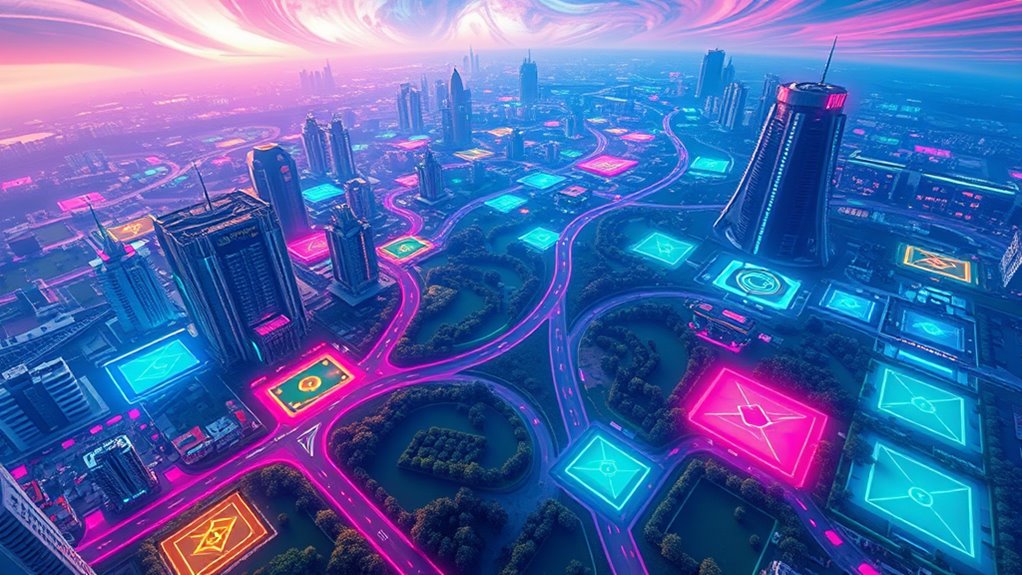
The future of virtual land and NFTs in the Metaverse presents a transformative opportunity for digital ownership and economic growth. As virtual land becomes increasingly valuable, platforms like Decentraland and The Sandbox facilitate buying, selling, and developing digital properties.
The Metaverse unlocks new possibilities for digital ownership and economic expansion through valuable virtual land and innovative NFT platforms.
Tokenization through NFTs guarantees secure transactions, enhancing transparency in virtual real estate. The limited availability of virtual land creates scarcity, driving investor interest.
Additionally, owners can generate revenue through various means, such as advertising and hosting events. As the Metaverse expands, the demand for virtual land is expected to rise, attracting forward-thinking investors. Innovations like interoperability and enhanced realism will likely shape the future landscape, providing new avenues for engagement and creativity within digital environments. Furthermore, the use of music NFTs allows artists to establish ownership and create unique experiences for fans within the Metaverse.
Frequently Asked Questions
How Do I Ensure the Security of My Virtual Land Investment?
To guarantee the security of a virtual land investment, one should utilize strong passwords, enable multi-factor authentication, conduct thorough research on platforms, and store assets in secure wallets, minimizing risks associated with scams and unauthorized access.
Can Virtual Land NFTS Be Used in Multiple Metaverse Platforms?
Currently, virtual land NFTs are largely confined to their original metaverse platforms. While the potential for interoperability exists, significant technical barriers prevent seamless usage across different environments, limiting their utility and integration in the digital domain.
What Happens if a Metaverse Platform Shuts Down?
When a metaverse platform shuts down, users and creators face significant challenges, including the loss of resources, disrupted communities, diminished value of digital assets, and complex migration processes, ultimately leading to economic repercussions and market volatility.
How Can I Monetize My Virtual Land Effectively?
To effectively monetize virtual land, one can explore rental agreements, host events, develop unique content, and lease advertising spaces. These strategies leverage demand while fostering community engagement and maximizing potential revenue opportunities.
Are There Any Taxes on Virtual Land Transactions?
In the vibrant domain of digital landscapes, virtual land transactions are subject to taxation. Each sale or purchase stirs capital gains, while rentals may yield ordinary income, creating a complex tapestry of financial obligations for owners.
Conclusion
To summarize, the metaverse and virtual land NFTs represent a burgeoning frontier in digital interaction and ownership. As technology advances, the significance of virtual real estate becomes increasingly clear, offering diverse opportunities for users and investors alike. While challenges such as regulation remain, the potential for growth is vast. As the saying goes, “where there’s smoke, there’s fire,” indicating that interest in this digital domain is likely to intensify, shaping the future of virtual landscapes.



